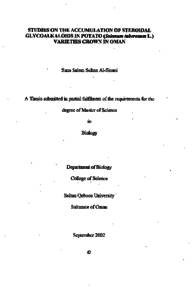وثيقة
Studies on the accumulation of steroidal glycoalkaloids in potato (solanum tuberosum L.) varieties grown in Oman.
الناشر
Sultan Qaboos University
ميلادي
2002
اللغة
الأنجليزية
الموضوع
الملخص الإنجليزي
The glycoalkaloid content in 18 potato varieties grown in Oman was determined by HPLC in both the peel and the flesh. The total glycoalkaloid content of the tubers was found to be variety dependent and varied greatly between the 18 varieties. The total glycoalkaloid in the tubers of Estima, Vivaldi, Caesar, Christle, Rosseta, No. 3, and Cantate was within the safe limit of $200 mg/kg FW recommended for food safety, whereas the remaining 11 varieties exceeded the upper limit. The principal glycoalkaloids a-solanine and c-chaconine were present in higher concentration in the peel than in the flesh of all varieties. Peel 73-100% of the total glycoalkaloid present in whole tuber. The main alkaloid in the peel was c-chaconine comprising 60-81% of the total glycoalkaloids. The high concentration of a-chaconine in the peel, which is more toxic than a-solanine, gives more protection to the tuber against predators and/or pathogens. The flesh of all 18 varieties contained total glycoalkaloid levels lower than the upper safety limit, and their al-chaconine and a-solanine contents were variable between the varieties. Most of the 18 varieties grown in Oman showed high levels of total glycoalkaloids and may represent a danger to human health especially in the absence of proper peeling.
The leaves of the 18 varieties were analyzed for glycoalkaloids. The levels of glycoalkaloids in young leaves were higher than that of mature leaves except in Cyclon, No. 3, Clair, Durby, Estima, and Caesar. The principal alka young and mature leaves was a-chaconine which represented between 74-100% of the total glycoalkaloids in the leaves. The levels of glycoalkaloids in leaves and tubers showed a positive correlation.
Tubers from 7 potato varieties were analyzed for their rates of glycoalkaloid accumulation in response to stresses such as mechanical injury, light, and low temperature storage. Mechanical injuries of tubers greatly stimulated glycoalkaloid accumulation in both peel and flesh of tubers. The extent of glycoalkaloid accumulation depends on variety, type of mechanical injury, and storage period. Most of the injury-stimulated glycoalkaloid accumulation occurred within 7-14 days after treatments. Cutting of the tubers resulted in the highest content of glycoalkaloids both in flesh and peel up to levels that exceeded the upper safety limit of 200 mg/kg FW. Injury stimulated a-solanine accumulation in tubers more than a-chaconine, resulting in a decrease in the c-chaconine: c-solanine ratio.
Exposure to fluorescent light (15.72 umol m2 s2 photosynthetically active radiation) resulted in an increase in the glycoalkaloid concentration within tuber tissue and in a decrease in the a-chaconine: a-solanine ratio.
Tubers were stored at low temperature, the rate of glycoalkaloid accumulation was independent of the glycoalkaloid level at harvest. The greatest increase in total glycoalkaloid content of the seven varieties was found after two weeks of storage at both 4 °C and 10 °C. Further storage at these temperatures resulted in a decrease in the rate of glycoalkaloid accumulation in most of them. At 10 °C glycoalkaloid content tended to increase more rapidly than at 4 °C. The a solanine content of the tubers showed an increase following low temperature storage.
المجموعة
URL المصدر
الملخص العربي
تمت دراسة الألكالويدات السكرية في ۱۸ نوع من نباتات البطاطس التي تزرع بسلطنة عمان باستخدام جهاز الفصل الكروماتوغرافي عالي الفعالية وذلك في كل من قشرة البطاطس وفي جسم الدرنة. وجدت الدراسة تفاوتا بين كمية الألكالويدات في العينات وقد احتوت سبعة منها على الكالويدات لا تتعدى المستوى الأمن للإستخدام البشري (وهو ۲۰۰ ملجم/كجم وزن رطب) في حين احتوی ۱۱ نوع على كمية الكالويدات أكثر من المستوى الأمن للإستخدام البشري. وجدت الدراسة أن مركبي السولانین والجاكونين موجودان بتركيزات عالية في قشرة كل الأنواع. ووجدت أن إزالة القشرة تزيل ۷۳ – ۱۰۰% من الألكالويدات الموجودة بالدرنة. احتوت القشرة على تركيز أكبر للجاكونين (وهو الأكثر سمية) مما يوحي بأن له دورا أكبر في إسباغ الحماية على الدرنة. تمت دراسة الألكالويدات في أوراق البطاطس وقد وجدت الدراسة أن الأوراق الصغيرة تحتوي على تركيز أكبر من الألكالويدات مقارنة بالأوراق البالغة. كذلك تمت دراسة تراكم الألكالويدات كنتيجة لبعض التأثيرات البيئية مثل التخزين تحت درجة حرارة منخفضة أو تحت الإضاءة أو كنتيجة للجروح أو أي إصابة للدرنات وهو ما يمكن أن يحدث أثناء النقل والتخزين. وجدت الدراسة أن الجروح والإصابات عموما تزيد من تركيز الألكالويدات وكذلك التخزين تحت الإضاءة الشديدة، أما التخزين في درجة حرارة منخفضة فإن تركيز الألكالويدات في درجة ۱۰°م أكبر منه في درجة حرارة 24م.
قالب العنصر
الرسائل والأطروحات الجامعية

